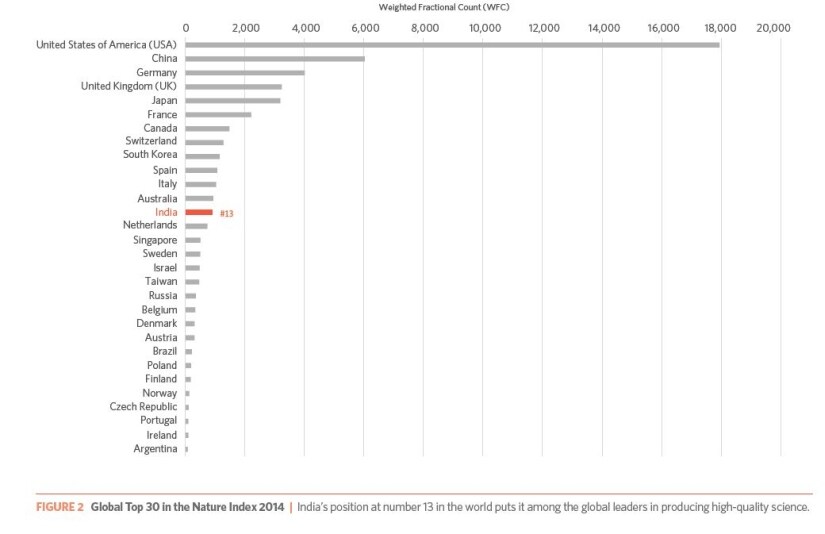By Dinesh C Sharma India’s achievements in space science such as low-cost inter-planetary mission to the Mars and multi-wavelength space observatory are well recognized at home and abroad. However, the work of scores of scientists working in several other disciplines does not even get mentioned forget the limelight. Their work may not be as catchy as a space mission but is certainly good enough to place India in the top 15 countries doing high quality research, as revealed by a new study. There has been a discernible increase in India’s scientific output as measured in terms of research published in 68 high-quality science journals. Since 2012, the country’s Weighted Fractional Count (WFC) – a measure of relative contribution of scientists to research papers- has increased by 185. As a result of this growth, India has been ranked 13th globally in 2014, sandwiched between Australia and the Netherlands, with a weighted fractional count of 921.8. The data has been published by Nature Index, developed by top journal Nature. China ranks number 2, after America. [caption id=“attachment_2564404” align=“alignnone” width=“825”]  Source: Nature[/caption] The surge in Indian output is seen despite stag — nation in spending on research and development (R&D) — the figure has been hovering around 1 percent of GDP for two decades. The past two budgets presented by the current government have, in fact, saw expenditure going down in real terms. The 2014 budget earmarked about 362.69 billion rupees ($6 billion) for scientific departments including space and atomic energy. This amount was below inflation increase, with allocations for some sectors going down greatly. In 2015, this alloca¬tion was marginally higher at 419 billion rupees ($6.4 billion). While Russia, Brazil and Italy spent at similar levels (between 1 and 1.5 percent of GDP), only Italy recorded a weighted fractional count higher than India’s. Australia, Singapore and South Korea spend higher proportions of their GDP on R&D, India’s weighted fractional count surpassed that of Singapore, equaled with Australia and is closing the gap with South Korea. This only shows that Indian researchers are giving more value for money spent on science. However, the reports notes, “problems such as bureaucracy, government indifference, unfair appoint¬ments and lack of resources” continue to be dampeners. Another positive trend in Indian science is growing international collaborations. In 2014, India scientists co-authored research papers with researchers from 85 countries. Most such collaborative work was with researchers in America, Germany, other European countries, East Asia and Aus¬tralia. In terms of disciplines, India’s output in chemistry was far greater than other subjects. In this area, top Indian institutions are competitive with those in Europe, America and Asia. The country stood ninth in the global ranking for chemistry and half the weightage for overall output came from chemistry alone. The rest came from materials science, nanosciences and astrophysics, among others. The Nature Index 2014 shows India lags life sciences as well as earth and environmental research, though some institutes are doing very well in life sciences individually. Leading the institutions responsible for high quality scientific output are Indian Institutes of Technol-ogy, followed by laboratories of Council of Scientific and Industrial Research (CSIR) and the Indian Institutes of Science Education and Research (IISER). In addition, Indian Insti¬tute of Science (IISc), Tata Institute of Fundamen¬tal Research, Jawaharlal Nehru Centre for Advanced Scientific Research, Harish-Chandra Research Institute, University of Hyderabad and Saha Institute of Nuclear Physics contributed to th research output. When compared with foreign institutions for international repu¬tation and comparative global ranks, the IITs ranked 51st in the index, placing them close to top universities in Asia such as Nanyang Technological University and National Univer¬sity of Singapore in Singapore. The IITs also rank close to top institutions in Europe and America and surpass some of the world’s top research hubs like LMU in Germany and RIKEN in Japan. If the government spending is stagnating, private sector too is lagging in R&D as well as collaboration with Indian institutes. The index showed almost no industry collaborations, except for IIT Kanpur’s tie up with a couple of companies. This does not mean there is no joint work with industry. It is there but mostly with international corporations. The same is true for industry – Indian companies are mainly collaborating with international academic institutions through their international branches. Examples of such work include tie-ups with foreign institutes of Serum Institute of India, Dr Reddy’s Laboratories, Tata Steel, Shasun Pharmaceuticals, Hikal, BioOrganics and Applied Materials, Reliance Industries Limited, Pondicherry Biotech Private and Panacea Biotec. The message for policy makers and the government is clear: if India wants to make a mark as an emerging power globally, it would have to increase investment in R&D. The UPA under Manmohan Singh had promised to double the figure from 1 percent of GDP to 2 percent. Though it went up marginally, but could never reach the figure of 2 percent. As the next session of Indian Science Congress is held in Mysore next week, one can only hope the NDA regime would take steps to correct the situation and enhance R&D expenditure.
India’s achievements in space science such as low-cost inter-planetary mission to the Mars and multi-wavelength space observatory are well recognized at home and abroad.
Advertisement
End of Article
Written by FP Archives
see more


)
)
)
)
)
)
)
)
)



